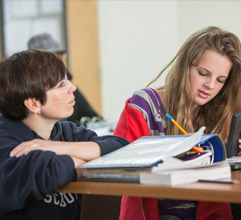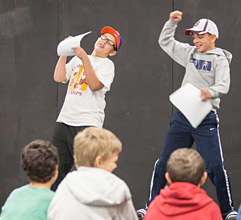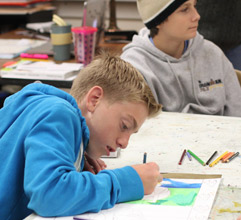Eighth Grade



The Middle School program offers a bridge from Elementary School to High School. The Middle School has its own wing in the Middle Building, and takes most of its classes in that wing, but interaction with younger students continues in formal (Sharing Assemblies, After School Enrichment, reading buddies) and informal (recess) settings.
Eighth graders take yearlong classes in English, Math, Introduction to Physical Science, World History and Spanish. They also take one trimester each of Transition to High School, Art and Drama.
English class focuses on a study of literature that is both contemporary and classic. Emphasis is placed upon the mastery of grammar and editing skills as well as vocabulary enrichment. The major theme of all reading and writing assignments is journey and transition.
The Math curriculum presents important concepts in the context of engaging problems, and also provides personalized, differentiated skills practice. Students will learn to: know that there are numbers that are not rational, and approximate them by rational numbers; work with radicals and integer exponents; understand the connections between proportional relationships, lines and linear equations; analyze and solve linear equations and pairs of simultaneous linear equations; define, evaluate and compare functions; use functions to model relationships between quantities; understand congruence and similarity using physical models, transparencies or geometry software; summarize and define distributions; solve real-world and mathematical problems involving volume of cylinders, cones and spheres; investigate patterns of association in bivariate data.
Introduction to Physical Science serves as an introduction to chemistry (periodic table, bonds, equations and reactions) and physics (motion and force, structure and matter, waves and energy). Beginning with the idea of scientific method and methods of observation, we hope to ingrain the process of science exploration for the high school years.
In Ancient History, our goal is for students to gain a thorough understanding of ancient European and Middle Eastern civilizations. Students will read historical fiction; re-enact events/daily life in the various time periods; debate; research events and teach each other; and explore art work and its relationship to and reflection of the culture. Modern day events are incorporated whenever possible with the goal of assisting students in establishing a stronger connection to people and events of the past.
Spanish uses the TPRS (Teaching Proficiency through Reading and Storytelling) method of instruction, which immerses students in hearing the language in a relaxed and fun setting; students experience the language rather than learn about it in English.
Transition to High School helps students identify personal strengths and weaknesses, set goals, practice test-taking skills, role-play interview scenarios, write a strong application and make choices based on reasonable outcomes.
Art includes work in a variety of media: drawing, painting, sculpture, printmaking and mixed media. Assignments are designed to develop skills and challenge students to think and solve problems. Students are encouraged to get ideas and inspiration from art appreciation that will introduce past masters and present-day artists.
Drama begins as an acting class, in which concepts, terms and techniques are introduced, practiced through exercises, and reflected on during critiques. The class determines by consensus the nature of their final project, which culminates in an evening performance. The remainder of the trimester consists of rehearsals, coaching and critiquing.
In Health Education, our goals are to develop a caring community and to encourage choices that promote physical wellness, personal safety and positive self-esteem. The focus is on preventable diseases, healthy relationships and responsibility. Students build an age-appropriate foundation of knowledge that supports healthy choices and healthy living.
